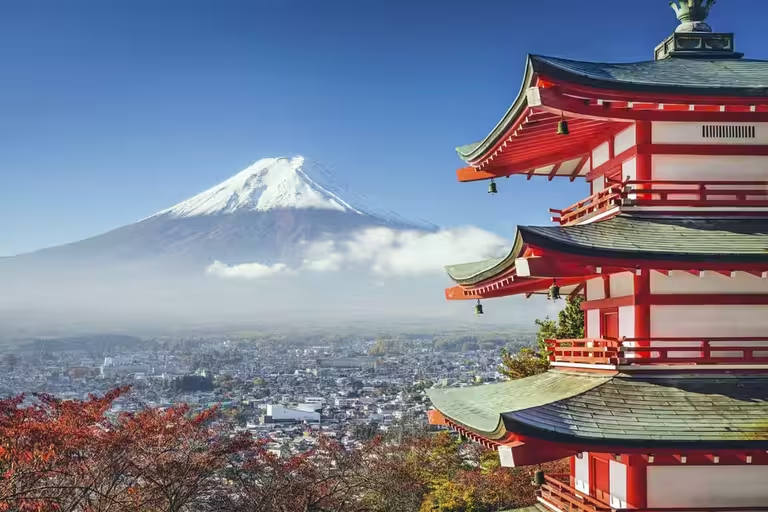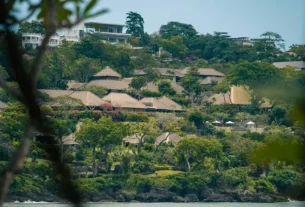Mount Fuji, Japan’s iconic and tallest mountain, attracts millions of hikers, climbers, and tourists annually. However, the growing popularity of the mountain has led to increasing environmental concerns, particularly due to the extensive vehicular traffic that contributes to pollution, habitat disruption, and road congestion. To address these issues and create a more sustainable and efficient means of transportation for visitors, Japan is exploring plans for a light rail line that could transport up to 3 million hikers each year to and from the base of Mount Fuji.
This proposed light rail project has sparked widespread interest and debate, with stakeholders discussing the potential economic, environmental, and cultural impacts. Below, we dive into the specifics of the project, the motivation behind its creation, the potential benefits, and some of the challenges that could arise.
Mount Fuji’s Growing Popularity and Environmental Impact
Mount Fuji, with its stunning symmetrical form and cultural significance, is a UNESCO World Heritage site and a symbol of Japan. Each year, nearly 5 million visitors from across the globe make their way to the area, with approximately 300,000 hiking up to the summit during the official climbing season in summer.
This influx of hikers has placed a significant burden on the mountain’s infrastructure, natural habitats, and surrounding communities. Increased traffic, especially during the peak summer months, has led to problems such as:
- Traffic congestion on access roads: Roads leading up to the base of Mount Fuji are often clogged with vehicles, particularly tour buses and private cars.
- Pollution and littering: With more visitors comes an increase in waste, pollution, and litter, which harms the mountain’s ecosystems.
- Pressure on local resources: Water, sanitation, and waste management services are under strain due to the high volume of visitors.
As a result, both environmental activists and local communities have voiced concerns over the sustainability of Mount Fuji as a major tourist destination. The need for a more eco-friendly and efficient transportation solution has become clear, leading to the idea of a dedicated light rail line.
The Proposed Light Rail Project: An Overview
The Mount Fuji light rail line is being envisioned as a low-impact, sustainable transit system designed specifically for tourists and hikers. Although the exact details of the project are still under discussion, here are some key features of the proposed light rail system:
- Route: The rail line would likely run from key transit hubs or nearby cities to the popular fifth station, which is the primary starting point for many hikers aiming to reach the summit.
- Capacity: With an estimated capacity to transport 3 million people per year, the rail line would drastically reduce the reliance on private cars and buses, leading to a substantial decrease in road congestion.
- Sustainable Technology: The rail line is expected to utilize clean energy and employ technologies to minimize noise and environmental disruption.
By providing a dedicated rail line for tourists and hikers, the project aims to reduce the environmental impact on Mount Fuji while enhancing the experience for visitors. This initiative aligns with Japan’s broader sustainability goals and its commitment to preserving natural and cultural heritage sites.
Key Benefits of the Mount Fuji Light Rail Line
The proposed light rail line could provide a range of benefits, from environmental conservation to economic gains. Below are some of the key advantages that are expected:
1. Reduced Environmental Impact
One of the primary motivations for the light rail project is to reduce the environmental footprint of Mount Fuji’s tourism industry. With fewer cars and buses on the roads, there will be:
- Less air pollution: Vehicles emit pollutants that can harm both the mountain’s ecosystems and the health of visitors and residents. A rail system powered by clean energy could drastically cut these emissions.
- Decreased road erosion: Heavy vehicular traffic accelerates wear and tear on roads, necessitating frequent repairs that disrupt local habitats. A rail line could help alleviate this issue.
- Controlled visitor flow: By regulating the number of visitors that can access the mountain, the light rail line could help prevent overcrowding, which negatively impacts both the environment and the visitor experience.
2. Enhanced Visitor Experience
The light rail line is anticipated to offer a more comfortable, scenic, and convenient journey to Mount Fuji, benefiting tourists in multiple ways:
- Reduced travel times: Without the congestion of traditional roadways, visitors can expect shorter travel times, allowing them to spend more time exploring the mountain.
- Accessibility for all: A rail system would likely be more accessible for people with disabilities, families, and older visitors, making Mount Fuji an inclusive destination for all.
- Scenic views: Light rail travel offers an opportunity for tourists to enjoy the scenic landscapes of the Mount Fuji area without the stress of driving or dealing with traffic.
3. Economic Boost for Local Communities
The light rail line could drive significant economic benefits for communities near Mount Fuji by:
- Creating job opportunities: The construction and operation of the rail line would create jobs for locals, from skilled construction roles to customer service positions in the transportation and tourism sectors.
- Increasing tourist spending: A streamlined, efficient transportation system could encourage more tourists to visit nearby towns and attractions, boosting the local economy.
- Promoting regional development: Infrastructure improvements associated with the light rail line could spur further investment in the area, supporting long-term economic growth.
Potential Challenges and Concerns
While the light rail line offers numerous potential benefits, it also presents several challenges and concerns that must be addressed to ensure its success:
1. High Construction and Maintenance Costs
Building a light rail system is an expensive endeavor, and the initial investment needed for construction, as well as ongoing maintenance, could be substantial. Stakeholders must consider how these costs will be covered and whether ticket prices will be affordable for tourists and locals.
2. Environmental and Cultural Sensitivity
Despite its eco-friendly design, the rail line’s construction could disturb sensitive areas, requiring careful planning to avoid damage to natural habitats. Additionally, Mount Fuji holds significant cultural and spiritual importance in Japan, and any development must respect these values.
3. Potential Opposition from Local Communities
Some local residents may be concerned about the impact of the rail line on their way of life. Increased tourism, while beneficial for the economy, could disrupt the daily lives of residents and lead to overcrowding in nearby towns.
Insights from Similar Projects Around the World
Looking at similar projects worldwide can offer valuable insights into the potential impact of the Mount Fuji light rail project. Notable examples include:
- The Jungfrau Railway in Switzerland: This railway line takes tourists to the base of the Jungfrau Mountain, minimizing vehicular congestion in the area while providing a scenic, eco-friendly journey.
- The Banff Gondola in Canada: Designed to reduce environmental impact, the gondola offers an alternative to road travel in Banff National Park, a popular mountainous region in Canada.
By studying these and other cases, project planners can identify best practices and avoid common pitfalls in developing the Mount Fuji light rail line.
Steps Toward Sustainability and Responsible Tourism
The Mount Fuji light rail line represents a step toward more sustainable tourism practices. This project could potentially become a model for similar tourist-heavy locations that face environmental pressures due to high visitor numbers. In line with this goal, additional measures could include:
- Visitor Education Programs: Educating tourists on responsible travel behavior and the importance of conservation can lead to better environmental practices.
- Waste Management Initiatives: Proper waste disposal and recycling facilities along the route and at Mount Fuji could help reduce littering and maintain the mountain’s natural beauty.
- Seasonal Restrictions: By implementing peak season restrictions, the number of visitors during critical times could be controlled, allowing for year-round access that is sustainable.
What the Future Holds for Mount Fuji and Japanese Tourism
As Japan continues to attract global attention for its natural and cultural landmarks, the Mount Fuji light rail project may set a new standard in sustainable tourism. If successful, this initiative could encourage other popular tourist sites in Japan to adopt similar measures, addressing environmental concerns and enhancing visitor experiences.
Tourism is a vital part of Japan’s economy, and as interest in Mount Fuji grows, projects like this could help maintain the country’s commitment to environmental preservation. By creating a more sustainable infrastructure, Japan has the opportunity to balance the needs of its tourism industry with those of its environment and local communities.
A Step Forward in Protecting Japan’s Natural Heritage
In conclusion, the proposed light rail line to Mount Fuji could mark a new chapter in the mountain’s history, transforming it into a beacon of sustainable tourism. With careful planning, consultation with local stakeholders, and an emphasis on environmental protection, this project could not only benefit Mount Fuji but also set a global example for how popular natural attractions can be enjoyed responsibly.
As Mount Fuji faces the future, this light rail line offers a path to preserve its natural beauty, cultural significance, and accessibility for generations to come.





